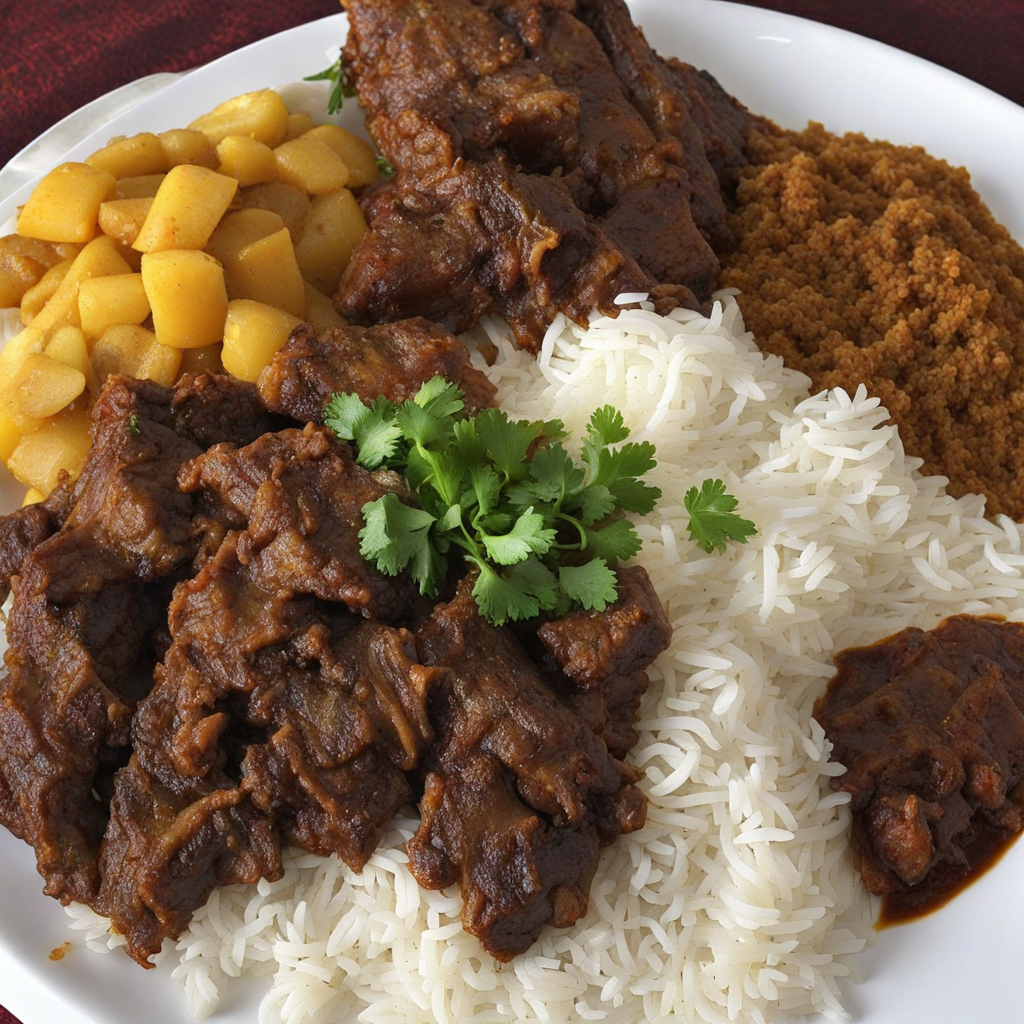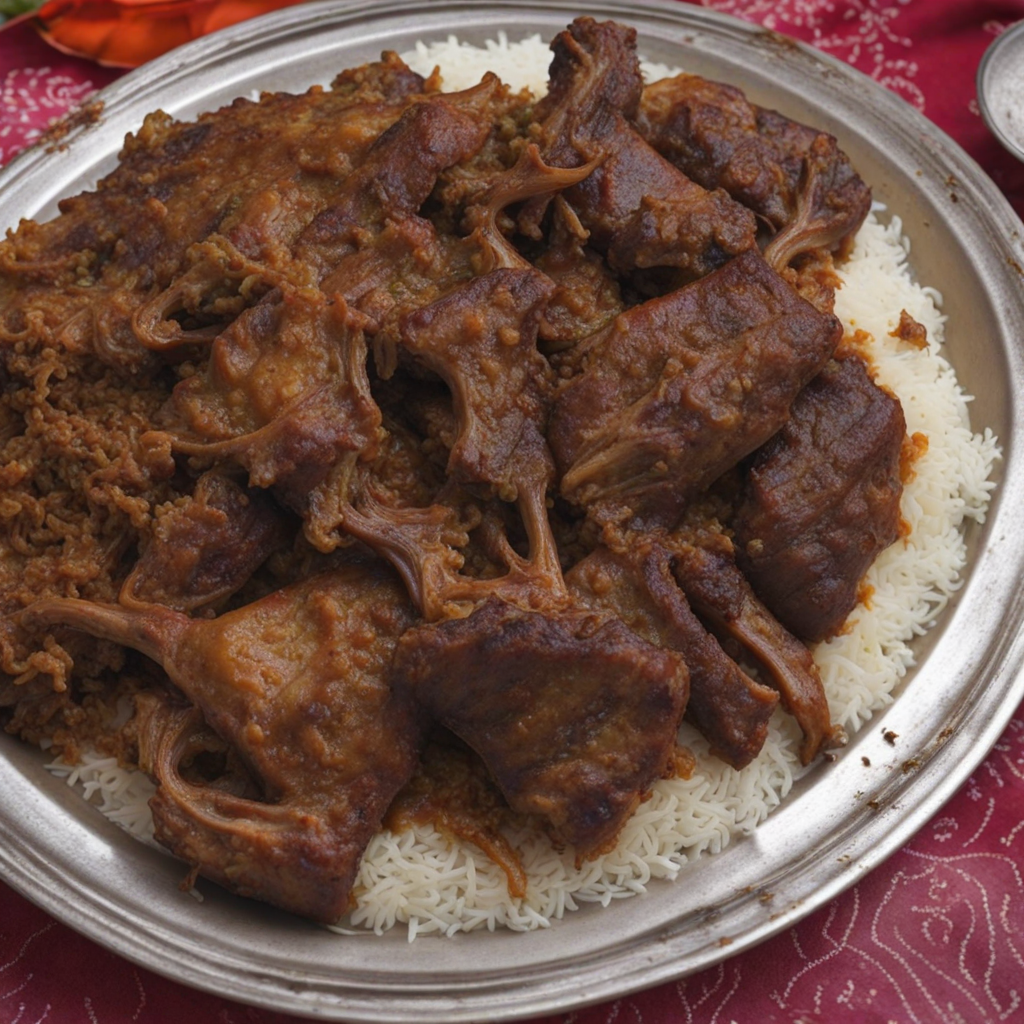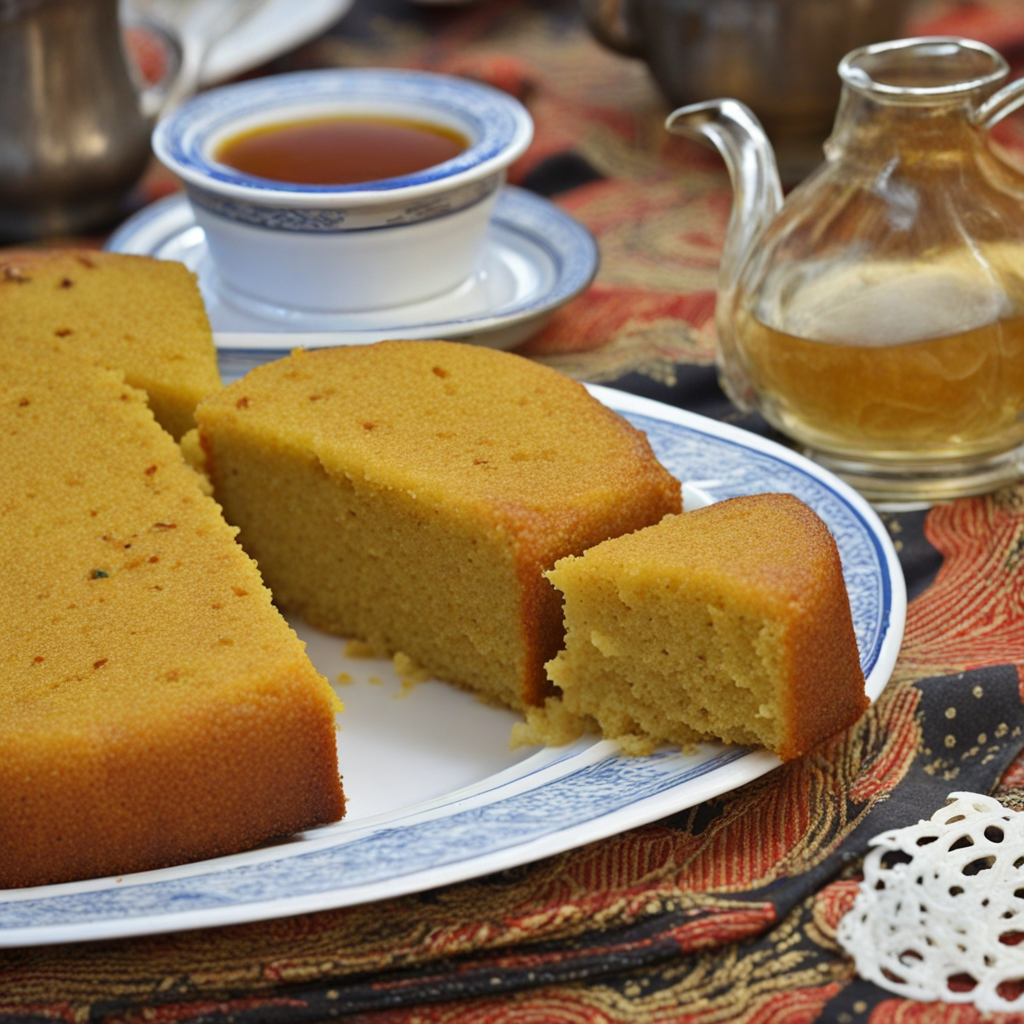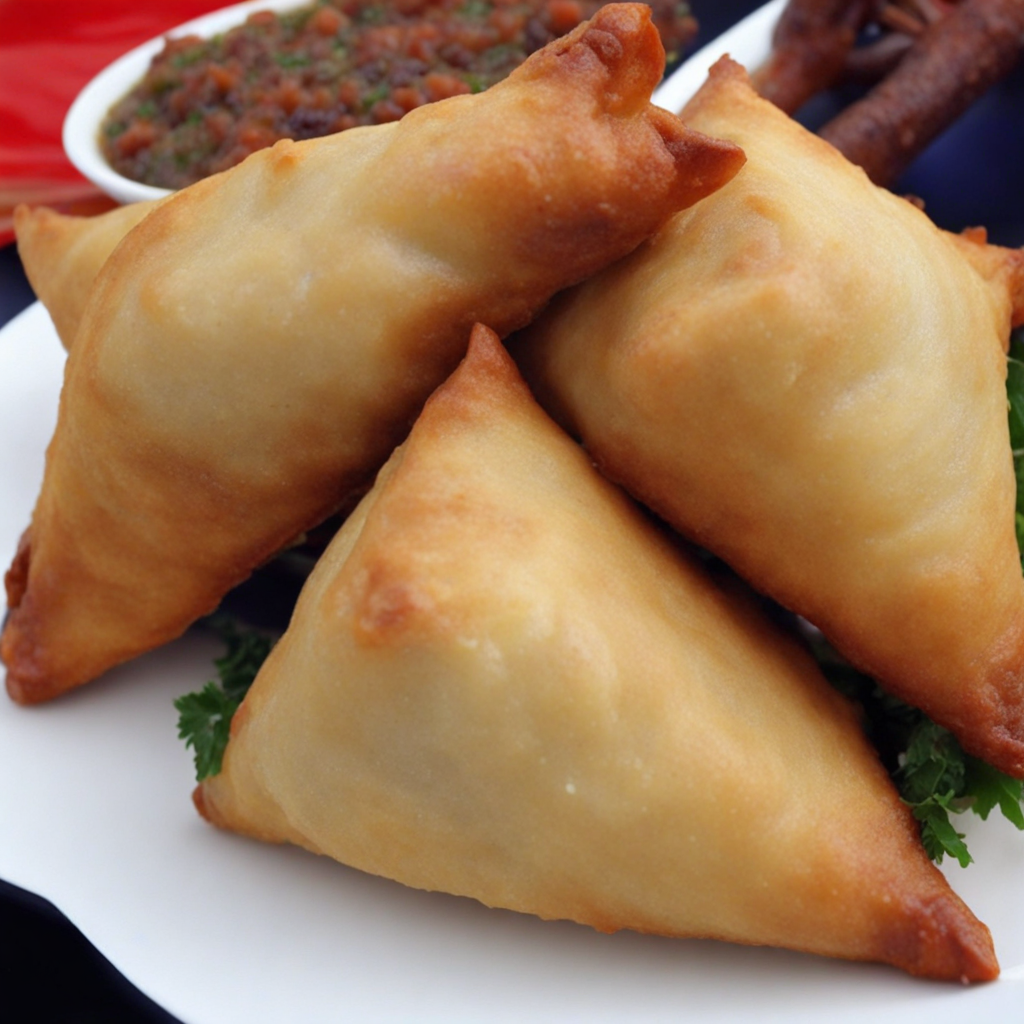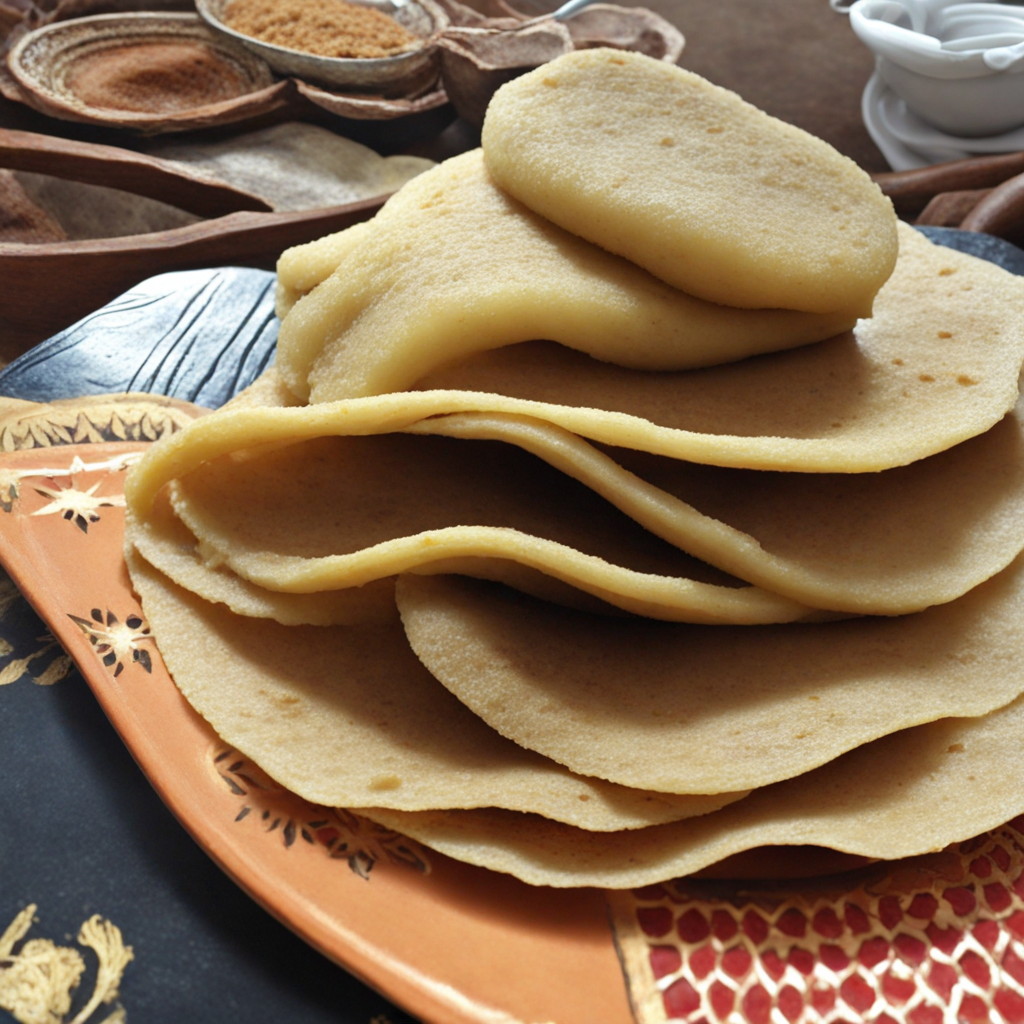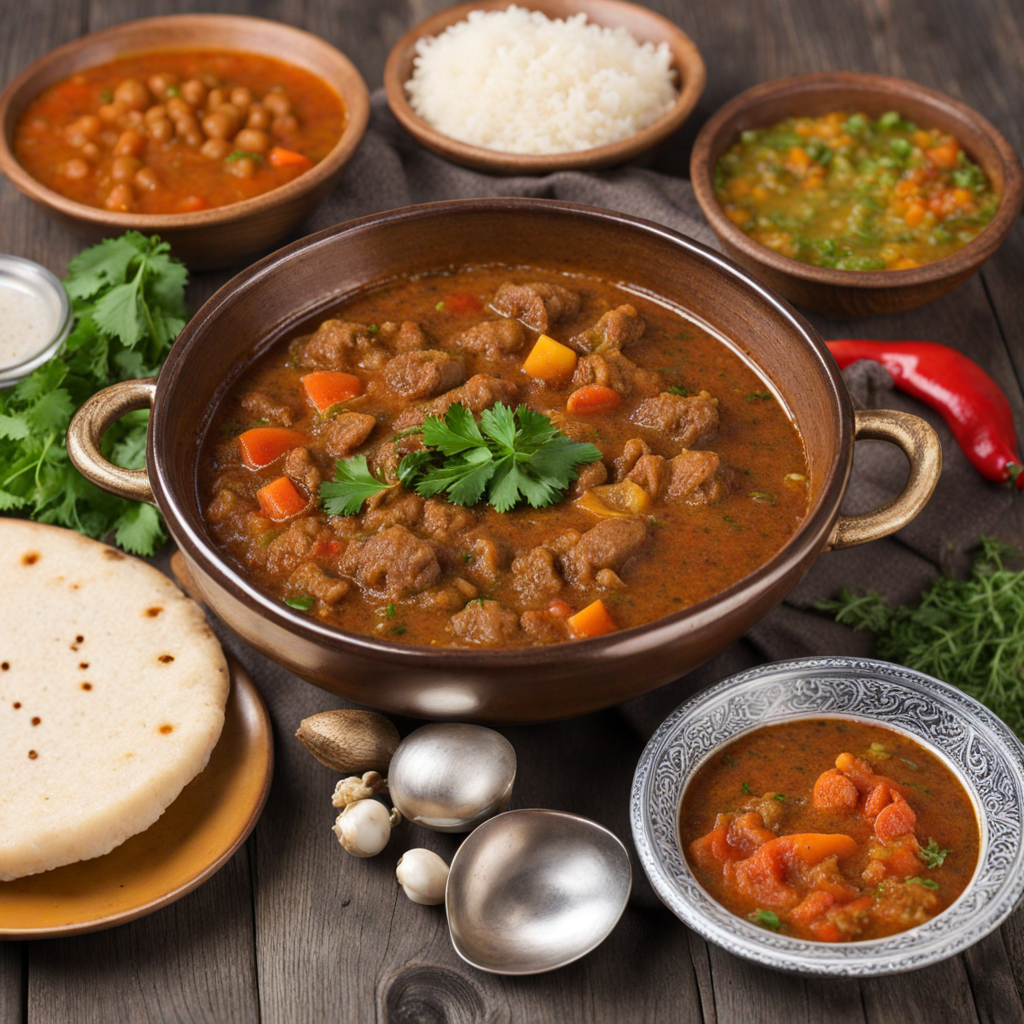Hilib Ari
Hilib Ari, a traditional Somali dish, showcases the rich culinary heritage of Somalia with its unique blend of flavors and spices. The name translates to "goat meat," which is the star ingredient of this hearty dish. Typically, the meat is marinated with a mixture of spices such as cumin, coriander, and black pepper, giving it a warm and aromatic profile. The marination process not only enhances the flavor but also tenderizes the meat, allowing it to absorb the spices deeply. Once seasoned, the goat meat is slow-cooked to perfection, resulting in a succulent and juicy texture that melts in your mouth. The dish is often accompanied by a side of fragrant rice, which is typically cooked with spices and sometimes enriched with saffron or cardamom, adding an aromatic touch that perfectly complements the robust flavors of the Hilib Ari. In some regions, it might be served alongside a refreshing salad or a tangy sauce made with tomatoes and chili, providing a delightful contrast to the richness of the meat. The interplay of spices in Hilib Ari is a testament to the Somali tradition of using locally sourced ingredients to create dishes that are both satisfying and full of character. For those looking to explore new culinary experiences, Hilib Ari is a must-try. It encapsulates the heart of Somali cuisine, where communal dining is celebrated, and flavors are bold and vibrant. Each bite offers a glimpse into the culture and traditions of Somalia, making it not just a meal but a culinary journey that leaves a lasting impression. Perfect for gatherings or family meals, Hilib Ari promises to introduce your palate to the warmth and richness of Somali flavors, inviting you to savor each moment spent at the table.
How It Became This Dish
The History of هليب أري (Halib Ari): A Somali Culinary Treasure #### Origins of هليب أري Halib Ari, a traditional Somali dish, translates to “milk with meat.” This unique combination features a flavorful blend of fresh milk—typically cow’s milk—and tender cuts of meat, often goat or lamb. The origins of Halib Ari can be traced back to the pastoral nomadic lifestyle of the Somali people, who have relied on livestock farming for centuries. Somalia's geographic location on the Horn of Africa has endowed it with a diverse array of natural resources, primarily livestock, which has played a crucial role in shaping its culinary practices. The Somali pastoralists have long understood the importance of milk as a staple food, providing essential nutrients and a source of hydration in the arid climate. In terms of its historical roots, Halib Ari embodies the essence of Somali culture and heritage. The dish is likely inspired by ancient practices of combining dairy and meat, a method observed in various cultures around the world, but Halib Ari stands out due to its distinct Somali flavors and preparation techniques. #### Cultural Significance Halib Ari is more than just a dish; it is a symbol of hospitality and community within Somali culture. Traditionally served during gatherings, celebrations, and important social events, this dish is often prepared for guests and family members to convey respect and generosity. In Somali society, the act of sharing food signifies connection and kinship, and Halib Ari plays a vital role in these communal experiences. The dish is also significant during religious occasions, such as Eid al-Adha, when communities come together to celebrate sacrifice and gratitude. Halib Ari, with its rich flavors and nourishing ingredients, embodies the spirit of these festivities. It is often accompanied by traditional Somali flatbreads, or lahoh, which further enhances the communal dining experience. Furthermore, Halib Ari reflects the rich tapestry of Somali identity. The preparation of the dish can vary significantly between regions and families, showcasing unique spices and cooking methods passed down through generations. As such, the dish serves as a culinary marker of regional diversity and cultural pride within Somalia. #### Development Over Time The evolution of Halib Ari has been influenced by various factors, including trade, migration, and globalization. Historically, the Somali people engaged in extensive trade with neighboring regions, which facilitated the exchange of ingredients and cooking techniques. Spices such as cumin, coriander, and cardamom, which are now integral to the dish, may have been introduced through these interactions. In the late 19th and early 20th centuries, Somalia experienced significant political changes, including colonization by European powers. This period brought about shifts in agricultural practices and food availability, impacting traditional Somali cuisine. Despite these challenges, Halib Ari remained a beloved dish, adapting to new ingredients and influences while maintaining its core essence. The Somali diaspora, particularly following the civil war in the 1990s, has played a pivotal role in the globalization of Halib Ari. As Somali communities settled in various parts of the world—from the United States to Europe—the dish was introduced to new audiences. This migration has led to a fusion of culinary practices, with Halib Ari being adapted to include locally available ingredients while still honoring its origins. In contemporary times, Halib Ari has gained recognition beyond Somali communities. Food enthusiasts and cultural explorers have taken an interest in Somali cuisine, leading to the dish being featured in international food festivals and culinary events. This newfound appreciation has sparked a revival of traditional Somali cooking practices, encouraging younger generations to learn and preserve their culinary heritage. #### Preparation and Variations Halib Ari can be prepared in numerous ways, depending on regional preferences and family traditions. The primary components—milk and meat—are complemented by an array of spices that enhance the dish's flavor profile. A typical preparation begins with marinating the meat in a mixture of spices, including garlic, ginger, and black pepper, which infuses it with aromatic flavors. The meat is then cooked until tender, often simmered slowly to allow the flavors to meld. Fresh milk is gradually incorporated into the dish, creating a rich, creamy sauce that envelops the meat. Some variations include the addition of vegetables, such as carrots and potatoes, which not only add nutritional value but also contribute to the dish’s vibrant appearance. Accompanying Halib Ari are traditional Somali breads, such as lahoh or canjeero, which are used to scoop up the meat and sauce. This hands-on approach to dining emphasizes the communal aspect of the meal, inviting diners to engage with the food and each other. #### Halib Ari in Modern Context As Somalia continues to navigate its complex socio-political landscape, Halib Ari remains a powerful symbol of resilience and cultural continuity. The dish not only nourishes the body but also serves as a reminder of the rich history and traditions that define Somali identity. In recent years, there has been a growing movement to promote Somali cuisine on global platforms, with chefs and home cooks alike sharing recipes and stories through social media and food blogs. This digital age has provided an avenue for Somali culinary arts to flourish, attracting interest from food lovers eager to explore the flavors of the Horn of Africa. Moreover, as conversations around food sustainability and ethical eating gain traction, Halib Ari stands as an example of utilizing locally sourced ingredients. The emphasis on livestock farming within Somali culture aligns with contemporary discussions about supporting local economies and preserving traditional agricultural practices. Conclusion Halib Ari is more than just a dish; it is a culinary narrative woven into the fabric of Somali culture. Its origins reflect the pastoral lifestyle of the Somali people, while its cultural significance underscores the values of hospitality and community. Throughout history, Halib Ari has evolved, adapting to various influences while remaining a cherished staple among Somali families. As the world becomes increasingly interconnected, the appreciation for Halib Ari continues to grow, bridging cultural gaps and inviting people to experience the flavors of Somalia. In a time when culinary heritage is celebrated, Halib Ari stands as a testament to the power of food in fostering understanding, connection, and continuity across generations.
You may like
Discover local flavors from Somalia


